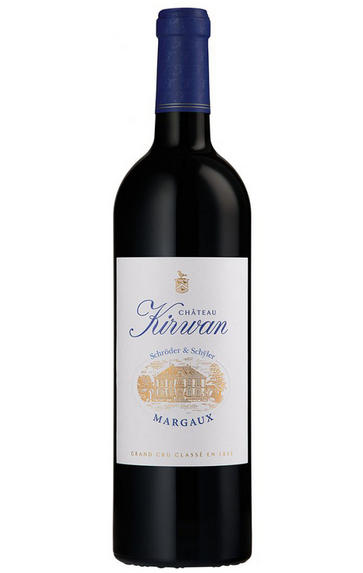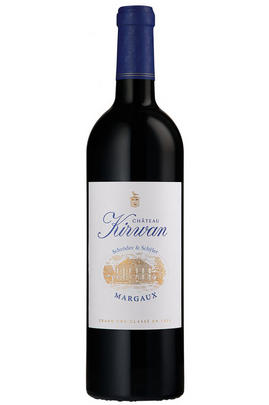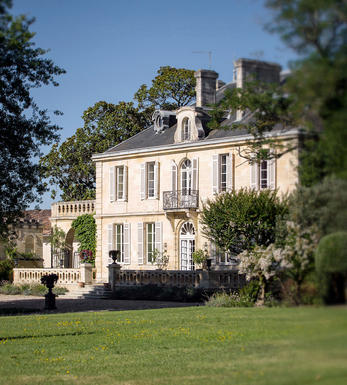
2005 Château Kirwan, Margaux, Bordeaux

Critics reviews
Robert M. Parker, Jr. - 29/06/2015
There is exceptionally rich and rounded Cabernet fruit here, but with the beguiling charm that one would expect from Margaux. Ten percent Petit Verdot in the blend adds a spicy complexity to the wine. Magnificent now, this will continue to develop well for another five or six years.
About this WINE

Chateau Kirwan
Château Kirwan is a 3ème Cru Classé Margaux property that has hit form in the last decade after years of producing wine not meriting its Cru Classé status. Kirwan takes its name from its Irish proprietor who was, rather unfortunately, guillotined in 1792.
Since 1925 Kirwan has been owned by the négociant firm, Schröder and Schÿler. The property is located in the commune of Cantenac and consists of a beautiful 18th century château and 35 hectares of vineyards.
The wine is typically a blend of 40% Cabernet Sauvignon, 30% Merlot, 20% Cabernet Franc and 10% Petit Verdot. The grapes are hand-harvested and then fermented in temperature-controlled, stainless-steel tanks. The wine is then matured in oak barriques (30-50% new) for 18 months. It is bottled after a light fining and filtration.
Michel Rolland has been consulting at Kirwan since the early 90s and the wines are now aromatically richer and have more grip and body, as well as displaying much more depth of fruit.

Margaux
If Pauillac can be seen as the bastion of ‘traditional’ Red Bordeaux, then Margaux represents its other facet in producing wines that are among Bordeaux’s most sensual and alluring. It is the largest commune in the Médoc, encompassing the communes of Cantenac, Soussans, Arsac and Labaude, in addition to Margaux itself. Located in the centre of the Haut-Médoc, Margaux is the closest of the important communes to the city of Bordeaux.
The soils in Margaux are the lightest and most gravelly of the Médoc, with some also containing a high percentage of sand. Vineyards located in Cantenac and Margaux make up the core of the appelation with the best vineyard sites being located on well-drained slopes, whose lighter soils give Margaux its deft touch and silky perfumes. Further away from the water, there is a greater clay content and the wines are less dramatically perfumed.
Margaux is the most diffuse of all the Médoc appelations with a reputation for scaling the heights with irreproachable wines such as Ch. Margaux and Ch. Palmer, but also plumbing the depths, with too many other châteaux not fulfilling their potential. There has been an upward shift in recent years, but the appellation cannot yet boast the reliability of St Julien. However, the finest Margaux are exquisitely perfumed and models of refinement and subtlety which have few parallels in Bordeaux.
Recommended Châteaux: Ch. Margaux, Ch. Palmer, Ch. Brane-Cantenac, Ch. Rauzan-Ségla , Ch. Dufort-Vivens, Ch. Ferrière, Ch. du Tertre, Ch. Giscours, Ch. d'Angludet.

Cabernet Sauvignon Blend
Cabernet Sauvignon lends itself particularly well in blends with Merlot. This is actually the archetypal Bordeaux blend, though in different proportions in the sub-regions and sometimes topped up with Cabernet Franc, Malbec, and Petit Verdot.
In the Médoc and Graves the percentage of Cabernet Sauvignon in the blend can range from 95% (Mouton-Rothschild) to as low as 40%. It is particularly suited to the dry, warm, free- draining, gravel-rich soils and is responsible for the redolent cassis characteristics as well as the depth of colour, tannic structure and pronounced acidity of Médoc wines. However 100% Cabernet Sauvignon wines can be slightly hollow-tasting in the middle palate and Merlot with its generous, fleshy fruit flavours acts as a perfect foil by filling in this cavity.
In St-Emilion and Pomerol, the blends are Merlot dominated as Cabernet Sauvignon can struggle to ripen there - when it is included, it adds structure and body to the wine. Sassicaia is the most famous Bordeaux blend in Italy and has spawned many imitations, whereby the blend is now firmly established in the New World and particularly in California and Australia.


Buying options
Add to wishlist
Description
A third-growth, this intense, powerful and concentrated wine should play to its strengths in a vintage such as 2005, with its enormous tannin and density. This is one of the more backward of the 2005s, quite masculine, tannic and bold, with a deep ruby/purple color, lots of spice, a touch of wood and new oak as well as a medium to full-bodied, rather backward, tannic mouthfeel. Its all there, and the wine certainly has plenty of concentration, but it needs another 3-5 years of cellaring. It should drink well for at least a quarter of a century.
Robert M. Parker, Jr. - 29/06/2015
wine at a glance
Delivery and quality guarantee